Shippers: Are you constantly referencing which shipping container dimensions you need?
We documented the container dimensions commonly used in ocean shipping. Bookmark it for easy access. Or, better yet, print the reference sheet and keep it on your desk.
This container reference sheet is part of our free toolkit. It includes four handy resources to help you optimize your shipments.
Shipping Container Dimensions & Types
Standard Container
Standard containers have rigid walls, roof, and floor.
Standard sizes:
- 20’ x 8’ x 8’6”, 38 CBM
- 40’ x 8’ x 8’6”, 68 CBM
- 40’ x 8’ x 9’6”*, 86 CBM
Best for: Most shipping needs; dry cargoes in boxes, bales, bags, and pallets
Open or closed: Completely enclosed with one end-wall door
Hardtop Container
Hardtop containers are made with steel rooftops.
Standard sizes:
- 20’ x 8’ x 8’6” , 38 CBM
- 40’ x 8’ x 8’6” , 68 CBM
- 40’ x 8’ x 9’6”*, 86 CBM
Best for: Heavier cargo and taller items
Open or closed: Removable roofs for crane loads; open door header on ends
Flatrack Container
These stackable containers have a steel frame and strong wood floors.
Standard sizes:
- 20’ x 8’ x 8’6”, 38 CBM
- 40’ x 8’ x 8’6” , 68 CBM
- 40’ x 8’ x 9’6”*, 86 CBM
Best for: Bulky cargo that’s over-sized (in width or length)
Open or closed: No sidewalls, fixed or collapsible end walls
Platform Container
This flat container is made from a wooden floor and steel frame.
Standard sizes:
- 20’ x 8’ x 8’6”, 38 CBM
- 40’ x 8’ x 8’6” , 68 CBM
Best for: Extremely heavy and oversized loads
Open or closed: Floor structure without walls
Open Top Container
Open top containers have a flexible, removable tarpaulin roof.
Standard sizes:
- 20’ x 8’ x 8’6”, 38 CBM
- 40’ x 8’ x 8’6” , 68 CBM
- 40’ x 8’ x 9’6”*, 86 CBM
Best for: Overheight, heavy, or bulky cargo
Open or closed: Movable/removable roof and bows, door header and end walls that swing out
Reefer Container
Reefer containers are refrigerated and often made of polyurethane foam for insulation.
Standard sizes:
- 20’ x 8’ x 8’6”, 38 CBM
- 40’ x 8’ x 8’6” , 68 CBM
- 40’ x 8’ x 9’6”*, 86 CBM
Best for: Temperature-sensitive and perishable goods
Open or closed: Closed, with adjustable ventilation
Insulated Container
Insulated containers are also refrigerated but have vessels or a clip-on unit to control temperature.
Standard sizes:
- 20’ x 8’ x 8’6”, 38 CBM
- 40’ x 8’ x 8’6”, 68 CBM
Best for: Temperature-sensitive goods that remain below freezing
Open or closed: Closed
Ventilated Container
Ventilated containers are similar to standard containers, but are better for ventilation.
Standard sizes:
- 20’ x 8’ x 8’6”, 38 CBM
Best for: Constant ventilation in various weather conditions
Open or closed: Closed with openings in top and bottom longitudinal rails
A Few Notes on Shipping Container Sizes:
* denotes a High Cube, or HC
Measurements also include CBM, or cubic meter
This CBM is measured by technical capacity, the capacity if every inch of the container were filled with liquid
A full container load, or FCL, is a shipment that takes up the entire container. A less than container load, or LCL, takes up less than a full container space. Why does it matter? When your team picks up ocean cargo from a terminal, FCL and LCL loads have different payment and release requirements. You can learn more here.
Print Your Reference Sheet for Container Dimensions




